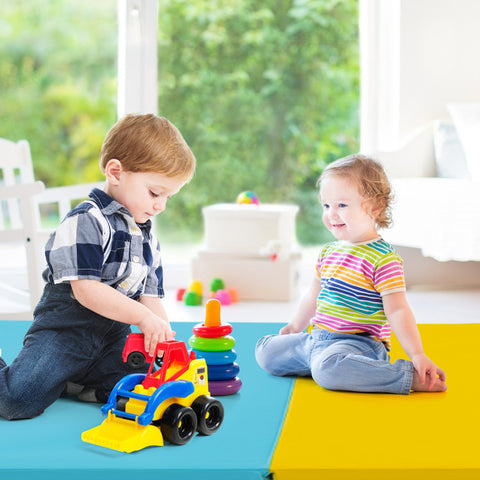News
The Importance of Slip Resistance in Gymnastics Mats: Ensuring Stability and Safety
In gymnastics, every movement demands precision, balance, and control. Whether performing a simple stretch or a high-intensity tumbling routine, one misstep can lead to injury. This is where slip resistance, an often underestimated but critical feature of gymnastics mats, plays a vital role.
Slip resistance ensures that athletes can train confidently without worrying about losing footing or the mat sliding on the floor. This article explores the science behind slip resistance, how it affects performance and safety, and what features to look for when selecting the best non-slip gymnastics mat.
What Is Slip Resistance in Gymnastics Mats?
Slip resistance refers to a mat’s ability to prevent unwanted movement between the athlete and the mat surface, as well as between the mat and the floor. In essence, it keeps both the gymnast’s body and the mat stable during training or performance.
It involves two main aspects:
- Surface grip: Prevents gymnasts from slipping when landing or transitioning.
- Base stability: Keeps the mat from shifting on smooth or polished floors.
This characteristic is achieved through textured surfaces, grip coatings, and anti-slip base materials.
The Science Behind Non-Slip Materials
Modern gymnastics mats use a combination of material technology and surface design to enhance traction.
- Textured vinyl or PU leather: Provides a micro-patterned surface that increases friction between the mat and the athlete’s body or shoes.
- Non-slip rubber backing: Ensures the mat stays firmly anchored to the floor, even during powerful jumps or rotations.
- Heat-sealed edges: Prevents curling at the sides, which could cause tripping or sliding.
The Coefficient of Friction (COF) — a measurable indicator of slip resistance — is a key parameter manufacturers use to test mat safety. Mats with higher COF values offer stronger grip, making them ideal for competitive and training use.
Why Slip Resistance Is Essential for Gymnasts
Slip resistance directly impacts both safety and performance consistency. Here’s why it matters:
- Prevents Slips and Falls: Gymnasts perform on their feet, hands, and even backs. A slippery surface can lead to dangerous falls or sprains.
- Supports Proper Technique: Stable footing allows gymnasts to focus on form rather than balance correction.
- Enhances Confidence: A mat that stays in place builds trust, encouraging athletes to perform with full intensity.
- Reduces Fatigue: Constantly adjusting balance on a slippery mat strains muscles and decreases endurance.
Surface Texture and Grip Technology
The texture of a gymnastics mat determines its friction level and comfort. Common grip technologies include:
- Embossed Patterns: Small raised dots or diamond textures improve traction without hurting skin.
- Matte Finishes: Reduce slickness from sweat and moisture, keeping the surface dry and grippy.
- Dual-Layer Coatings: A smooth top for comfort and a textured underlayer for maximum hold.
High-quality mats strike a balance — providing enough grip to prevent slipping but not so much that they restrict fluid motion.
Slip Resistance and Safety Standards
Professional gymnastics mats are tested for safety under international standards like:
- ASTM F2772: Specifies the performance characteristics of indoor sports floor systems, including slip resistance.
- EN 12503-1: European standard that defines surface friction requirements for gymnastic mats.
Choosing mats that meet these standards ensures compliance with globally accepted safety benchmarks.
How to Maintain Slip Resistance
Even the best mats can lose traction over time due to dirt, moisture, and wear. Regular maintenance is essential to preserve their anti-slip properties:
- Clean regularly with a mild soap and water solution to remove oils and dust.
- Avoid silicone-based cleaners — they reduce friction and make mats slippery.
- Keep mats dry after cleaning to prevent mildew and surface gloss.
- Inspect edges for curling or delamination that may reduce grip on the floor.
Factors to Consider When Buying a Non-Slip Gymnastics Mat
When purchasing a gymnastics mat with superior slip resistance, pay attention to:
- Material quality – Look for premium vinyl or reinforced PU leather.
- Surface finish – Textured or embossed surfaces provide better traction.
- Base type – Rubberized or suction-grip bases are ideal for polished floors.
- Thickness – Thicker mats may need stronger anti-slip backing due to weight distribution.
- Intended use – Tumbling and landing mats require stronger grip than stretching mats.
Conclusion
Slip resistance is not merely a design feature, it’s a critical safety component that defines the reliability of a gymnastics mat. A mat that grips securely enhances confidence, prevents injuries, and allows athletes to focus purely on performance.
Investing in a well-engineered non-slip gymnastics mat means investing in safety, precision, and long-term athletic growth.
FAQs
1. How do I know if a gymnastics mat has good slip resistance?
Check for textured or embossed surfaces and non-slip rubber bases. Reputable manufacturers often list the mat’s COF or safety certifications.
2. Can slip resistance decrease over time?
Yes. Dirt buildup and surface wear can reduce grip. Regular cleaning and inspection can maintain performance.
3. Are non-slip mats suitable for hardwood or tile floors?
Absolutely. Non-slip bases are designed to adhere firmly even to smooth surfaces, ensuring stability.
4. Is slip resistance more important for beginners or professionals?
Both. Beginners need stability to learn safely, while professionals rely on grip for executing complex maneuvers confidently.
5. What is the best surface texture for gymnastics mats?
Embossed or diamond-patterned textures are ideal as they balance grip, comfort, and ease of cleaning.


